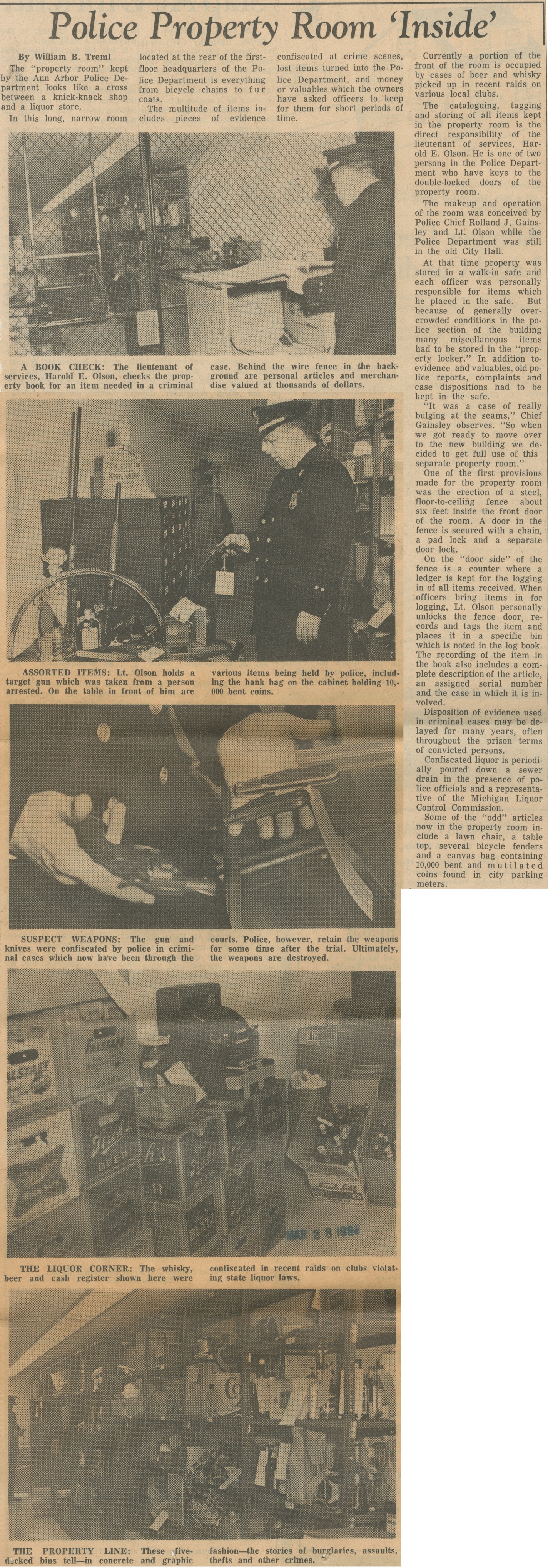Police Property Room 'Inside'

Police Property Room 'Inside'
By William B. Treml
The "property room" kept by the Ann Arbor Police Department looks like a cross between a knick-knack shop and liquor store.
In this long, narrow room
located at the rear of the first-floor headquarters of the Police Department is everything from bicycle chains to fur coats.
The multitude of items includes pieces of evidence
confiscated at crime scenes, lost items turned into the Police Department, and money or valuables which the owners have asked officers to keep them for short periods of time.
Currently a portion of the front of the room is occupied by cases of beer and whisky picked up in recent raids on various local clubs.
The cataloguing, tagging and storing of all items kept in the property room is the direct responsibility of the lieutenant of services, Harold E. Olson. He is one of two persons in the Police Department who have keys to the double-locked doors of the property room.
The makeup and operation of the room was conceived by Police Chief Rolland J. Gainsley and Lt. Olson while the Police Department was still in the old City Hall.
At that time property was stored in a walk-in safe. But because of generally over-crowded conditions in the police section of the building many miscellaneous items had to be stored in the "property locker." In addition to evidence and valuables, old police reports, complains and case dispositions had to be kept in the safe.
"It was a case of really bulging at the seams," Chief Gainsley observes. "So when we got ready to move over to the new building we decided to get full use of this separate property room."
One of the first provisions made for the property room was the erection of a steel, floor-to-ceiling fence about six feet inside the front door of the room. A door in the fence is secured with a chain, a pad lock and a separate door lock.
On the "door side" of the fence is a counter where a ledger is kept for the logging in of all items received. When officers bring items in for logging, Lt. Olson personally unlocks the fence door, records and tags the item and places it in a specific bin which is noted in the log book. The recording of the item in the book also includes a complete description of the article, an assigned serial number and the case in which it is involved.
Disposition of evidence used in criminal cases may be delayed for many years, often throughout the prison terms of convicted persons.
Confiscated liquor is periodically poured down a sewer drain in the presence of police officials and a representative of the Michigan Liquor Control Commission.
Some of the "odd" articles now in the property room include a lawn chair, a table top, several bicycle fenders and a canvas bag containing 10,000 bent and mutilated coins found in city parking meters.
A BOOK CHECK: The lieutenant of services, Harold E. Olson, checks the property book for an item needed in a criminal
case. Behind the wire fence in the background are personal articles and merchandise valued at thousands of dollars.
ASSORTED ITEMS: Lt. Olson holds a target gun which was taken from a person arrested. On the table in front of him are
various items being held by police, including the bank bag on the cabinet holding 10,000 bent coins.
SUSPECT WEAPONS: The gun and knives were confiscated by police in criminal cases which now have been through the
courts. Police, however, retain the weapons for some time after the trial. Ultimately, the weapons are destroyed.
THE LIQUOR CORNER: The whisky, beer and cash register shown here were
confiscated in recent raids on clubs violating state liquor laws.
THE PROPERTY LINE: These five-decked bins tell--in concrete and graphic
fashion--the stories of burglaries, assaults, thefts and other crimes.